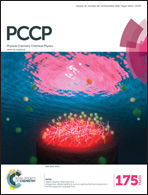Dynamics and yields for CHBrCl2 photodissociation from 215–265 nm†
Abstract
We investigate the Ã-band photodissociation of CHBrCl2 at 215, 225, 235, 245, 255, and 265 nm. Following C–Br bond cleavage, resonance enhanced multiphoton ionization and time of flight mass spectrometry provide selective detection of the two product channels, from which we quantify the relative quantum yield of Br/Br* production. Velocity-map imaging of the photofragments allows us to determine the energy partitioning as a function of the photolysis energy for different exit channels. The anisotropy present in the imaging data suggests that absorption to the 3Q0+(A′) state is important throughout the entire region we study, though competition with other excited states is evident. The 3Q0+(A′) state forms an avoided crossing with the 1Q1(A′) state, and we find that the propensity for adiabatic passage through this crossing region dictates the Br yield at longer wavelengths. At shorter wavelengths, Br production from excited states not subject to the crossing is more evident. While we find that spin–orbit excitation comes largely at the expense of the CHCl2 internal energy, both channels still produce highly excited CHCl2 photofragments. Impulsive modeling and comparison with similar halomethane dissociations suggests that a high degree of rotational excitation is present, dictated by the torque inherent in Cs-symmetry dissociation and the angular dependence of the potential.


 Please wait while we load your content...
Please wait while we load your content...